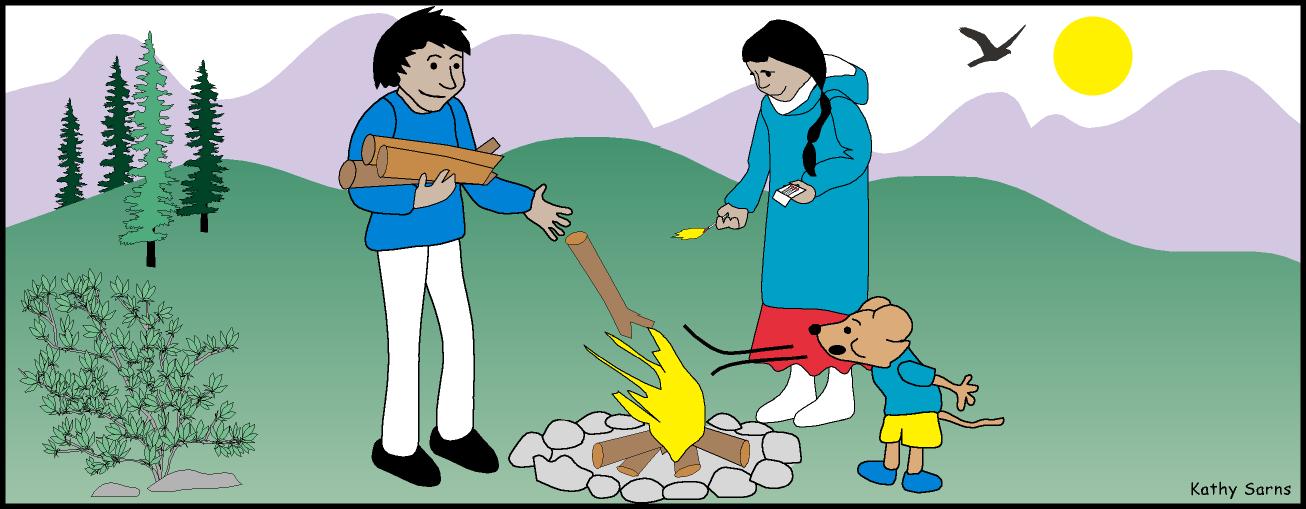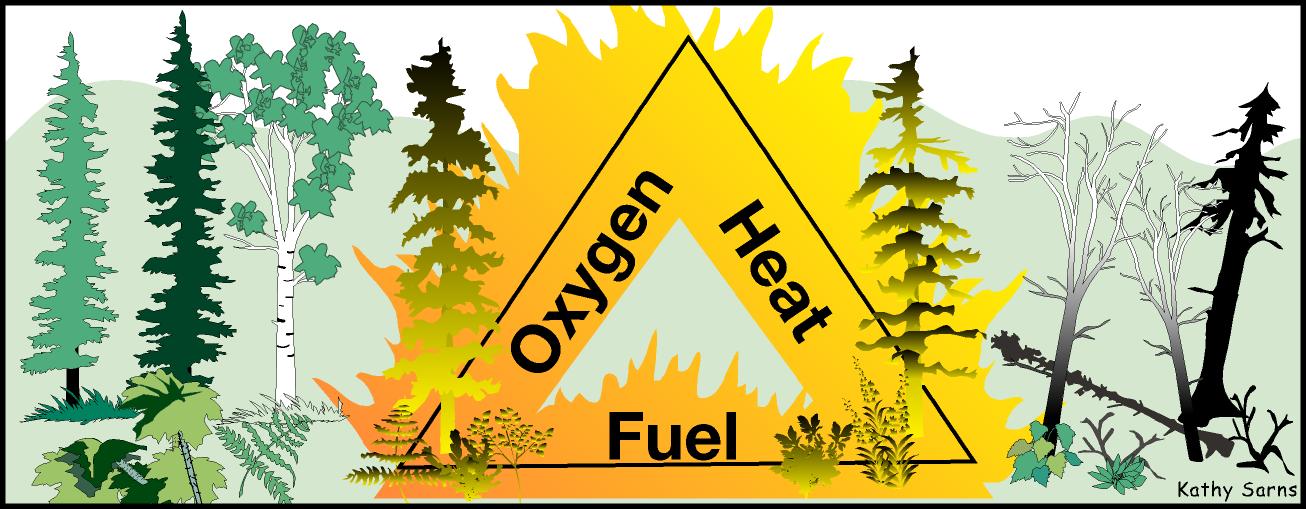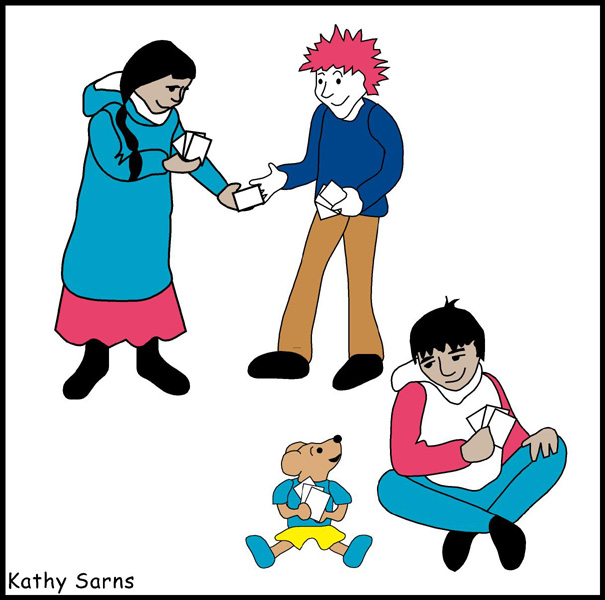
|
 |

| Grade Level: 5-12 |
| Alaska State Content Standards: SA14, SA15 |
| Subject: Science |
| Skills: Construction, Description |
| Duration: 30 minutes |
| Group Size: 4 |
| Setting: indoors |
| Vocabulary: fire triangle, fuel, surface fuel, ground fuel, duff, canopy fuel, oxygen, heat |
OBJECTIVE
Students will describe a fire triangle and its three components.
TEACHING STRATEGY
Students will create fire triangles by playing a card game. They will then use their fire
triangles to identify fire fuel types.
MATERIALS
![]() Tundra or Forest Fire Component Cards, 1 set per 4 students
Tundra or Forest Fire Component Cards, 1 set per 4 students
![]() Tundra Fire Fact Sheet (1 per student)
Tundra Fire Fact Sheet (1 per student)
![]() Forest Fire Fact Sheet (1 per student)
Forest Fire Fact Sheet (1 per student)
TEACHER BACKGROUND
Fire is a rapid chemical reaction that combines fuel and oxygen to produce heat and
light. An external source of heat is
usually required to start the reaction.
Once the fire has started, it produces the heat needed to continue
burning. There are three components
needed to start a fire: fuel, oxygen,
and heat. This is called a fire triangle. If any one of the components is missing, a
fire cannot occur.

A fuel is anything that will burn in a fire. Surface fuels lie on or right above the ground; surface fuels can be leaves, grass, dead wood, partially decomposed plants, stumps, or brush. Ground fuels lie beneath the ground surface. Duff is the organic layer of soil consisting of decaying leaves, roots, or other plant material. This material makes up much of the ground fuel. Canopy fuels include tree branches and leaves, dead standing trees, hanging beard lichens, and high brush.
Oxygen is found in the air. The amount of fresh oxygen available to a fire is often influenced by the wind. Compare this to making a campfire. What happens when you blow on the fire? Wind also helps the fire by blowing the heat towards more fuel, moving the fire by carrying sparks, and drying out the fuel through evaporation.
Heat is provided by nature in the form of lightning or volcanoes. In interior Alaska lightning starts many fires. Matches, campfires, and cigarettes are often the sources of heat in many human-caused fires.
To stop a fire the triangle must be broken. To slow down a fire, one of the three components of the triangle must be changed. Think about ways that large and small fires are controlled. A way to remove heat is to throw water onto a fire – the water absorbs heat and also cuts off oxygen. You could stop the flow of oxygen by throwing dirt on the fire, using a fire extinguisher, or dropping fire retardant from planes. The fuel supply could be removed by building a fire line around the fire.
ADVANCED PREPARATION
Copy, cut out, and laminate the Forest or Tundra Fire Component Cards. Make enough cards so that each student will receive three. Be sure there are equal numbers of fuel, heat, and oxygen cards.
PROCEDURE

- Discuss a fire triangle with the class as outlined in the Teacher Background section. To begin the discussion the teacher may wish to light a candle and ask the students what it needs to burn. Can you think of other ways fires might be started? Remember that once the fire has been started it produces its own heat. Place a jar over the candle. Students will probably know that the flame will go out. Why? (The oxygen has been eliminated.) How else could we extinguish the flame? (Cutting the wick from the candle removes the fuel. Wetting the flame removes oxygen and absorbs heat.) Draw a diagram of the fire triangle on the board.
- Discuss the different types of fuels, again found in the Teacher Background section. Pass out a copy of the "Tundra and Forest Fire Fact Sheet" handout to each student. Write examples for your ecosystem on the board.
- Shuffle the Forest or Tundra Fire Component Cards and give 3 to each student. Each student will try to create a fire by obtaining cards that could be arranged in a fire triangle. Students trade cards with each other until a triangle can be made. When successful, he or she stops and sits down.
- After all the trading is completed, allow the students to tell the class what components made up their fire. Make sure that each fire has all three components. If an incomplete triangle is formed, point out that no fire would have been started in that situation and discuss why. Ask the student or the class to describe the kind of fuel their fire used (ground, surface, or canopy). Students may be creative in solving this fire activity. If unusual triangles are created, ask the students to explain them to the class.
VARIATIONS
- Each student is given only one card. Students would then be instructed to locate two other students to form a fire. At the end of the activity, each group of students would discuss the fire they had created.
- Limit the number of fires by limiting the number of fuel, oxygen, or heat cards distributed. This will create a situation in which not all of the students will be able to form a fire triangle, demonstrating to the students that without all three components no fire can occur.
EVALUATION
Have students write their own Fire Component Cards with fuel from all 3 sources
(ground, surface, and canopy).
EXTENSIONS
Students bring in newspaper articles on local fires. Discuss what the three fire components
were in each case. If the fire was put out, how did the strategy work within the fire triangle concept? How was it extinguished?
REFERENCES
Used with permission from In Fire, the Story Behind a Force of Nature, “Fire: The
Force in With Us” by Jack DeGolia, KC Publications, 1989.
| Printable version | Add to favorites | Make Alaska FWS my homepage |
| Site designed and maintained jointly by the USFWS Alaska Region Division of Information Resource Management (IRM) and External Affairs (EA). |